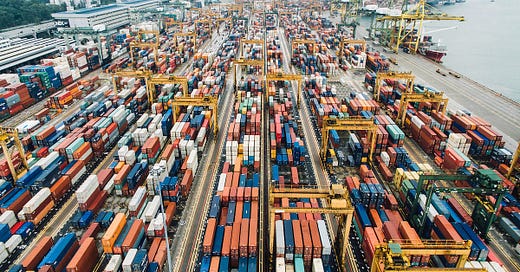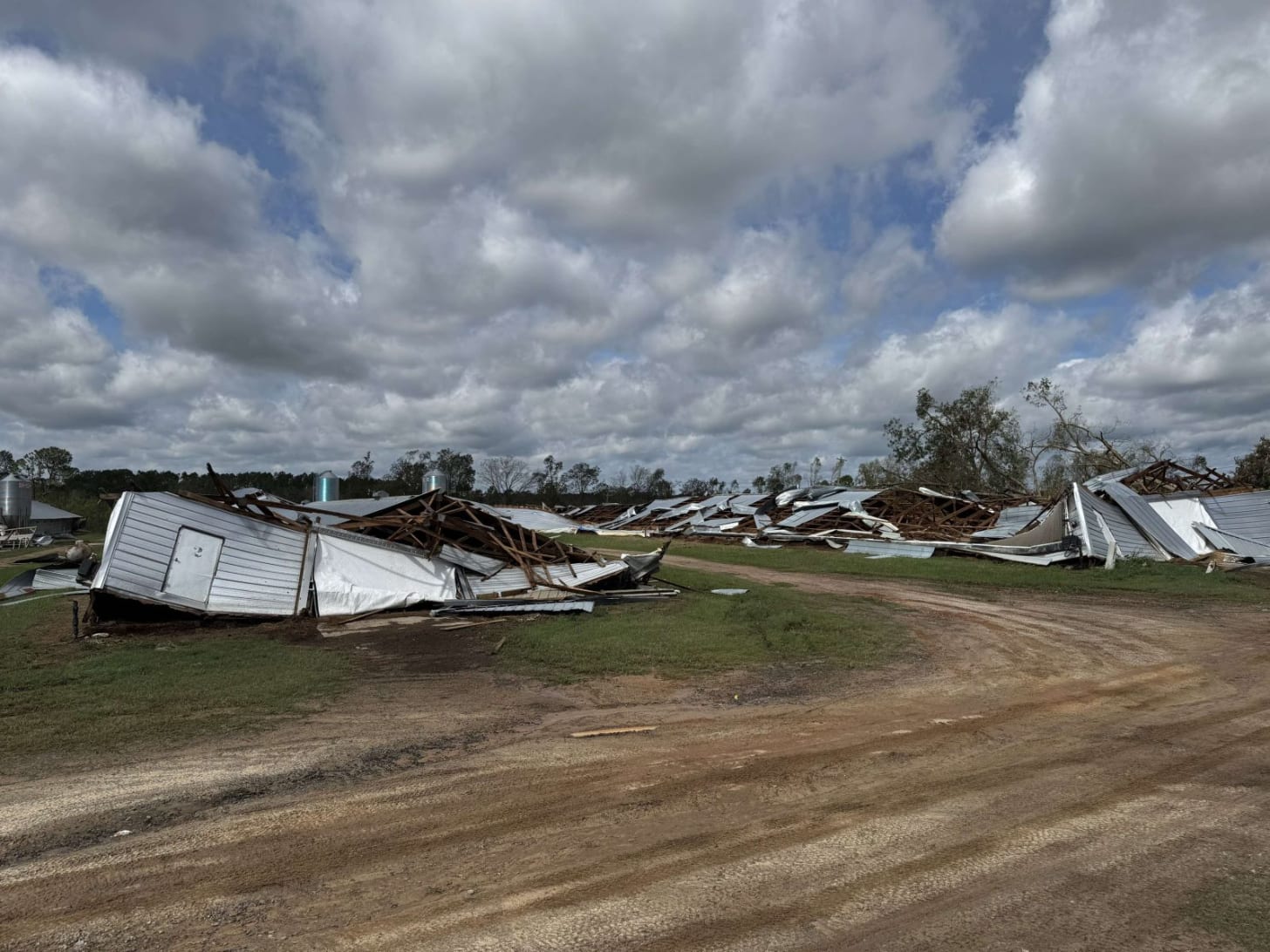The triple threat that's pushing America's food supply to the brink
Hurricane, farm bill expiration, and dock strike will likely lead to higher food prices, shortages, supply chain bottlenecks, and increased food insecurity. A snapshot of where we're at.
Hurricane Helene could not have come at a worse time for farmers and producers in the southern United States. Georgia’s Agriculture Commissioner, Tyler Harper says farmers were already facing “record setting drops in net farm income caused by inflation, high input costs, labor shortages, global competition, and low commodity prices.”
In a letter to his state’s leadership, he laid out the bare reality: “Right now, the future of hundreds of agricultural operations across Georgia is uncertain, and without immediate assistance, some will not make it to the next growing season.”
Farms across Georgia, Alabama, and Mississippi have been submerged in floodwaters or hit with wind damage, wiping out vast swaths of the crops intended to go to market. These states produce a significant portion of the nation’s cotton, soybeans, peanuts, and poultry, and early reports suggest that recovery could take months at least.
The immediate impact on food production is devastating. Without these crops, we can expect shortages in everything from fresh vegetables to grains and poultry products. Some cotton producers reported losses as high as 35% to total crop failure.
If you’re already noticing rising prices at the grocery store, buckle up — it’s about to get worse. When fields are wiped out, farmers can’t just replant the next day. The effects will linger, especially in a world where storms seem to strike more frequently and more violently each year.
For many families, this hurricane is a blow to food security. Local food systems in devastated regions will be disrupted, and as the broader national supply feels the squeeze, the cost of feeding your family could quickly rise. Food that was once abundant may become scarce.
As if the devastation from the hurricane wasn’t enough, the 2018 Farm Bill expired yesterday, and Congress has yet to pass a new one. The five-year piece of legislation officially expired last year, but Congress passed a one-year stopgap bill. Lawmakers are now deciding whether to pass a new version before the end of the year or extend the 2018 bill again.
For those unfamiliar, the Farm Bill is a massive piece of legislation providing vital support to America’s farmers and food programs. It includes not just funding for crop insurance and conservation initiatives, but also the Supplemental Nutrition Assistance Program (SNAP), which millions of Americans rely on for daily meals.
Without it, farmers already reeling from Helene’s destruction will face uncertainty about their future. Crop insurance programs, which help farmers rebuild after disasters, will be unfunded. This is a major lifeline that helps stabilize food prices, particularly after disasters like the one we’re experiencing right now. With no safety net in place, we may see higher food prices across the board as farmers are left to fend for themselves in a brutal market.
To top it all off, looming labor strikes along the East Coast threaten to bring shipping ports to a standstill. Dock workers, frustrated with stalled negotiations over pay and working conditions, are preparing to strike. The timing couldn’t be worse. Major ports like New York, New Jersey, and Charleston are critical entry points for imported food, and a strike would disrupt the already fragile supply chain.
We live in a world where a significant portion of our food — especially fresh produce, seafood, and packaged goods — comes from overseas. With dock workers walking off the job, these goods may sit on ships offshore, unable to make their way into stores. Even domestic products could see delays, as the ports are key links in the chain that moves goods across the country.
For the average consumer, this means slower restocking times, fewer choices, and even higher prices. We’ve already seen how quickly shelves empty when panic buying sets in, and this kind of disruption could reignite that cycle. People will start noticing that certain products simply aren’t available anymore — or, if they are, their prices have skyrocketed. Imported fruits, vegetables, and specialty items may disappear altogether for extended periods.
What this means for you — and how to prepare
With these three crises unfolding at once, the question isn’t if you’ll be affected but how soon and how badly. If you live in a region hit by the hurricane, food insecurity is a very real threat as local supply chains struggle to recover. For those elsewhere, the ripple effects of the farm bill’s expiration and labor strikes could show up in empty grocery store aisles and inflated prices.
So, how do you prepare when everything seems uncertain?
First, it’s essential to be proactive. Now is the time to start thinking about how you can shore up your own food security. This doesn’t mean panic-buying or hoarding, but rather making thoughtful decisions about your family’s needs in the coming months. Stocking up on non-perishables like canned goods, dried beans, rice, and pasta can provide a buffer if fresh food becomes scarce or too expensive. Think about diversifying your food sources as well. If you have access to local farms, farmers’ markets, or community-supported agriculture (CSA) programs, consider buying from them. These smaller, local producers might not be as vulnerable to the large-scale disruptions hitting industrial agriculture.
It’s also a good time to get strategic about reducing food waste. With prices rising and availability shrinking, being mindful of how we use the food we have will be crucial. Plan meals ahead of time, store food properly, and consider freezing perishable items to extend their shelf life.
Finally, stay informed. These crises are dynamic, and things can change quickly. Pay attention to news updates on the labor strikes and the Farm Bill negotiations, as well as local conditions in regions impacted by the hurricane. Knowing what’s happening will allow you to adapt your strategies as the situation evolves. Be sure to continue monitoring the weather; wild and unpredictable swings in long term patterns could mean unexpected impacts to where you live.
Don’t be caught off guard. These are uncertain times, but by taking small, practical steps now, we can all be a little better prepared for what’s coming. The food system may be fragile, but resilience starts at home.





In the short term things appear to be getting worse as far as food security, but if you take the long view maybe there is some hope. Whether these dock strikes and supply chain issues are random or maybe intended somehow (to speed up our demise) I don't know but it doesn't seem to matter too much. The old paradigm of Big Agra, Big Tech, Big Money growing unobstructed is now being questioned in many circles. It's become too big, too greedy and too fragile now. The system is based on destructive and disruptive mass farming practices that are unsustainable. It's morally bereft; trading short term profits for future sickness and demise. We now live in a time where we need to pull back from modern conveniences; instant food and gratification, and take responsibility for our own health. Once you realize you can't trust doctors, regulatory agencies, governments, media and so on, it's very discouraging to say the least. The food, the land, the air and water are being poisoned so do we really need to save this system of mass production? Ironically small organic and regenerative farms would help solve the climate crisis and the health crisis.
The duck and goose hunting in Georgia is going to be something else with all these flooded fields. Upside to everything!